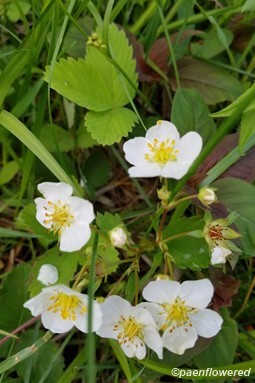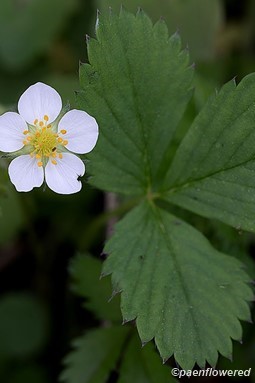Fragaria virginiana
An edible wild strawberry
Fragaria virginiana common strawberry
This native perennial species is similar to the domestic strawberry. It is a low plant with hairy stems. The leaves have three coarsely toothed leaflets on the end of a slender stalk. The flowers have round petals and are found on a separate stalk from the leaves. These flowers have five petals, 5 green sepals and 5 sepal-like bracts. There is a cluster of pistils in the center of the flower and a ring of 20-35 stamens with yellow anthers. These ½-¾ inch diameter flowers are almost always at about the same level above the ground as the leaves.
The red fruit does resemble the cultivated strawberry, but is smaller - about ½ inch in diameter. The seeds are embedded in pits and not as much on the surface of the fruit as in the domestic strawberry. The fruit is juicy and tart-sweet and quite edible by humans if the animals don’t get to it first.
This species is a widespread species in fields and edges of woods with a preference for medium wet to dry sunny areas. Otherwise it can be found in a variety of habitats. It can be found throughout North America and in every Pennsylvania county, and blooms from April to June. The plant can spread by runners and can form colonies. All strawberries have a basic haploid chromosome number of 7, but have duplicated them through a process called polyploidy. The wild strawberry has 8 sets of these chromosomes for a total of 56.
It is also called the Virginia strawberry. The wood strawberry (F. vesca ssp. vesca) is an alien species from Europe that has naturalized in the state. The leaflets are narrower and more pointed, the flowers are smaller and the flowers are usually held above the leaves. The cultivated strawberry is a hybrid between the wild strawberry and the coastal strawberry (F. chiloensis).
Habitat & Range
Common in old fields, meadows, and other dry, open grounds. Prefers full or partial sun and moist to mesic conditions.
Present throughout the state.
Range: Newfoundland and Alberta in Canada, down to Georgia, Tennessee, and Oklahoma in the United States
| EMP: | FACU |
|---|---|
| NCNE: | FACU |
Phenology
Flowers April to June. Blooming lasts 3 to 4 weeks.
Fruits in June.
Characteristics
Inflorescence umbel-like cluster of 2 to 6 stalked flowers; hairy peduncles shorter than the leaves even at maturity;
Flowers 5 white petals, 5 green sepals, 5 sepal-like bracts; stamens numerous with yellow anthers
Leaves dark bluish green, basal only; palmately compound with three obovate to oval leaflets that are 1-1 ½’’ long; margins coarsely serrate; terminal leaflet usually distinctly petiolate; leaf stalks are up to 6″ long
Stem stoloniferous, pubescent
Fruit individual achenes in pits distributed on the surface of an enlarged convex receptacle; receptacle fleshy, red, edible, egg-shaped
Height 4-8″
Similar Species
F. virginiana has fruit with seeds in pits while F. vesca has seeds right on the surface
F. virginiana has larger flowers that usually do not appear above the leaves.
F. virginiana has wider and less pointed leaves.
F. virginiana has a terminal leaflet that is usually distinctly petiolate while F. vesca's terminal leaflets tend to be sessile
Plant Codes
S-rank: S5 (Secure)
G-rank: G5 (Secure)
Ecology
The fruits are eaten by chipmunks, squirrels, and birds, making it an important food source in its ecosystem.
Primay pollinators are the short-tongued bees.
Serves as a host plant for over 70 species of butterflies and moths.







Comments
Have you spotted this plant in your area? We'd love to hear about your experience! Share your comments or questions about the plant below. Comments are moderated before posting.